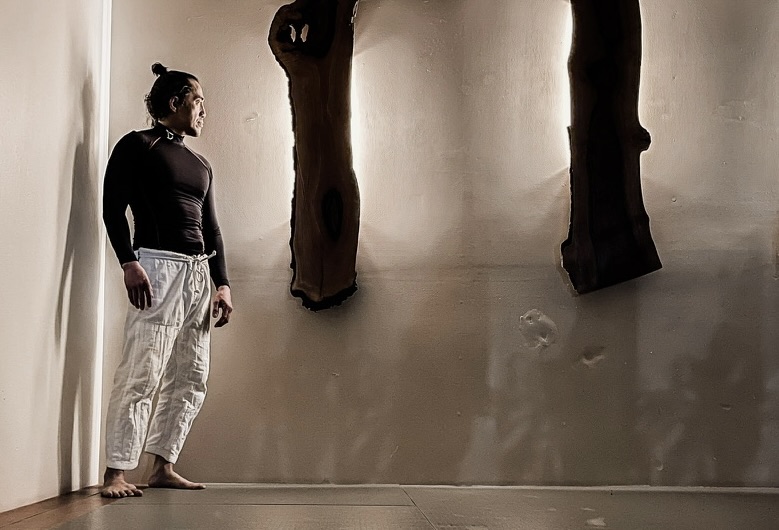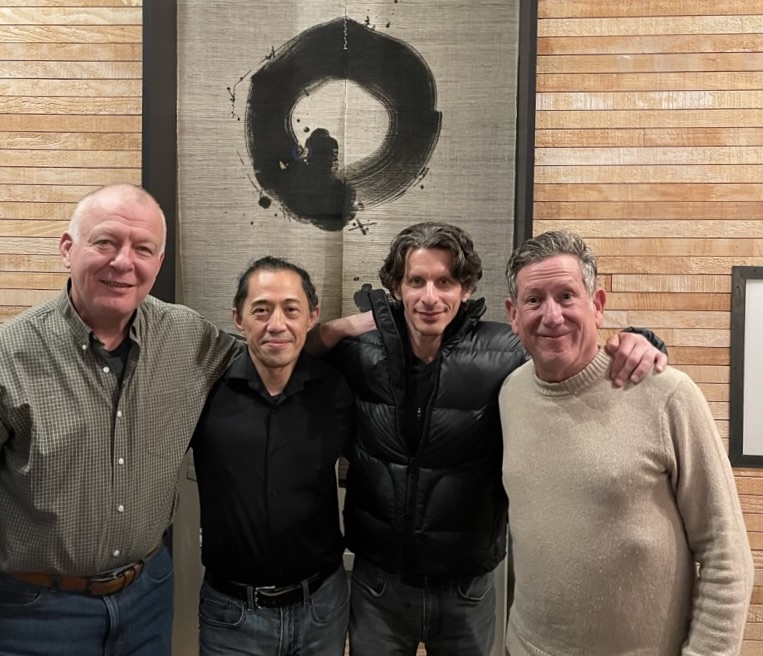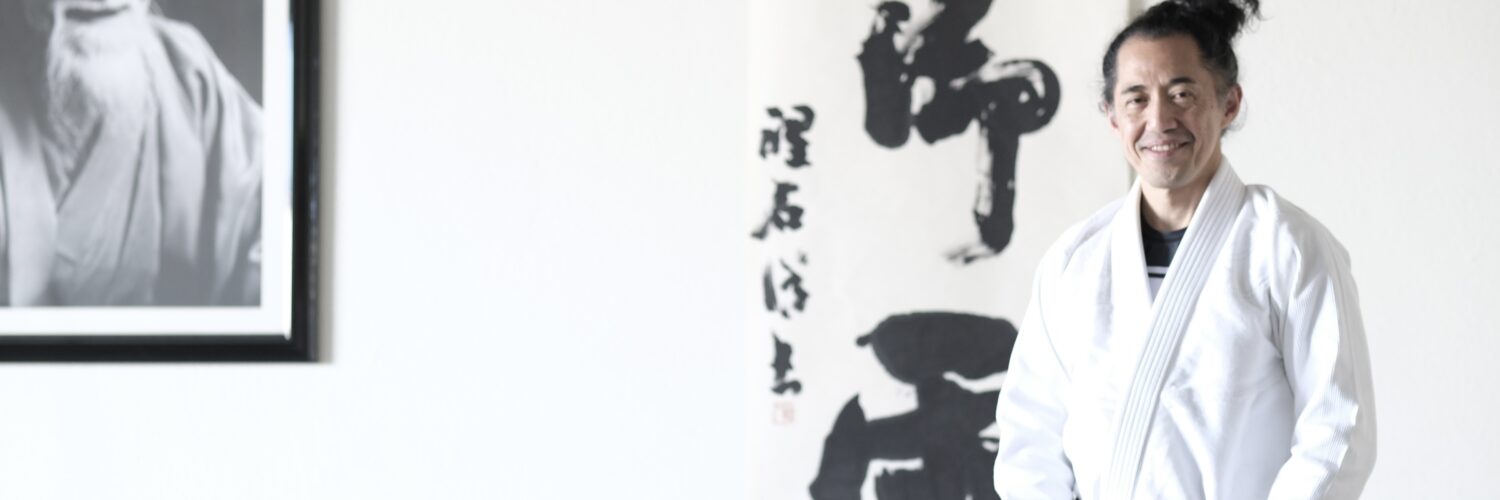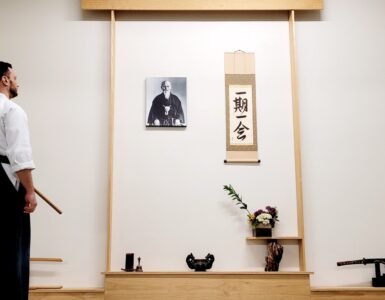In this interview, Ray Feliciano, a dedicated practitioner and teacher of Aikido, shares his journey through the world of the martial arts. From humble beginnings fueled by a passion for learning, Ray’s path led him to discover the transformative power of Aikido, Brazilian Jiu-Jitsu, Kali, and Shorinji Kempo. As a seasoned practitioner and instructor, Ray offers a fresh perspective on the role of Aikido in modern martial arts, emphasizing unity, adaptability, and the importance of moving the art forward for future generations.
Join us as Ray takes us through his experiences, challenges, and the lessons he’s learned along the way. Ray is a 6th degree black belt in Aikido, a black belt in Brazilian Jiu-Jitsu, and Chief Instructor of Maru Dojo in San Francisco and Pasadena Aikikai in Pasadena, CA.
Josh Gold: Can you share a little bit about what inspired you to get started in martial arts?

Ray Feliciano: All through my childhood, I’d wanted to get into martial arts, but being raised by a single mother, we simply could not afford it. I resorted to purchasing martial arts books, but that only took me so far.
In 1988, I was a bit older and gainfully employed. My mother just saw the movie Above the Law, and she suggested I see it. I was so inspired by the Aikido, especially Haruo Matsuoka Sensei’s ukemi. That was the beginning of my journey into the world of martial arts.
There was no internet at that time, but I found Pasadena Aikikai through a telephone directory and began my Aikido training there. I practiced hard and consistently and tested for my black belt 5 years later.
Who administered that test?
Francis Takahashi Sensei administered my shodan examination. All 4 examinees failed, myself included. It was disheartening. Quitting crossed my mind. Then I got a phone call from my instructor. He said, “Takahashi Sensei wants you to take another test a few months from now.” There was some reservation on my part to retake the test. My ego took a blow. But I had to see it through and keep moving forward. I did pass that second test and it was a great lesson in perseverance and humility for me.
That black belt test was a long time ago but you just recently earned a black belt in another art – Brazilian Jiu-Jitsu. What originally sparked your interest in BJJ?
After I passed my shodan test in Aikido, I started to take on some teaching responsibilities. During that period, lots of questions stated to arise- the “what if” questions. What if someone kicks you? What if someone is throwing jabs? What if someone tackles you? I couldn’t find anyone in Aikido who could answer those questions for me.
By that time, Brazilian Jiu-Jitsu was coming onto the scene. I was exposed to it by one of my dojo members. He was going to the Gracie Academy in Torrance. One day we practiced in his living room. He said we could spar for 5 minutes. He just sat on me; I couldn’t get out. Then he said, “Okay, five minutes is almost up. I’m going to tap you out.” And he did.
I was not enthusiastic about the art at that time. I walked away from that experience thinking that I’m a black belt now and had no desire to start another martial art as a beginner. Besides, I thought I’d never have to be concerned about anyone taking me to the ground, which was false thinking. That experience stuck around with me for quite some time.

It wasn’t until almost a decade later, around 2008, that I went all in. “I’m going to start training in Jiu-Jitsu. I’m going to wear the white belt again.” I never looked back after that.
I branched out even more after that. Around 2009, I also started training in Filipino Martial Arts (FMA) with Grand Master Castro in San Francisco along with Masters Dizon and Joseph. They taught me a variety of knife disarms, stick disarms and lock flows that further improved my Aikido skills.
“Francis Takahashi Sensei administered my shodan examination. All 4 examinees failed, myself included. It was disheartening. Quitting crossed my mind.”
Concurrently, I also trained in Shorinji Kenpo with Harada Sensei in San Francisco. There were similarities with Aikido in their wrist techniques and throws. But through Harada Sensei, I learned additional principles that further augment my understanding of Aikido.
It has been a long journey. Sometimes, you have to think outside the box to figure out the answers. You have to reach out to other people; they might have the answers already, and I don’t need to reinvent the wheel. I just reached out to ask. If you ask people, they will show you. That’s what I did.
I’ve had a lot of different instructors in the past and continue to do so, with the latest one being Professor Roy Dean, a wonderful Brazilian Jiu-Jitsu 4th dan black belt who also has a black belt in Aikido and Judo. I really appreciate his perspective on BJJ because he gives you the space to be who you are and develop in your own way.
What was your Brazilian Jiu-Jitsu black belt test like?
In 2020, we planned that a group from the Roy Dean Affiliate schools would travel to Japan for a seminar and there I would take my BJJ test. It did not happen due to the pandemic.
Following the tradition in Japanese martial arts, I waited for the Sensei to tap me on the shoulder to let me know it’s my time. In the early part of 2023, Roy did just that and informed me that it is my turn to go through the rite of passage. Hardee Merritt of Quest Martial Arts in Chapel Hill provided the perfect spot; a mountain dojo that sat in one of the hills of Blowing Rock, North Carolina.
“It wasn’t until…around 2008, that I went all in. “I’m going to start training in Jiu-Jitsu. I’m going to wear the white belt again.” I never looked back after that.”
I had a brief conversation with Roy Dean before the test, and he said, “This may be your last marital arts test, Ray.” And I said to him, “I think you’re right. I don’t think I want to take another test after this.”
The actual test was a grueling experience. It was an hour and a half long, at a very high elevation, and done with some very challenging training partners. It was an exhausting day. In the demo portion of the test, I integrated aspects of Aikido, FMA and even a bit of Shorinji Kempo. I’m honored to have joined the small number of Aikidoka yudansha who also hold a black belt in BJJ. It is an accomplishment with a lot of sacrifice.
Check out the video below to see the breathtaking location of Ray’s BJJ black belt test as well as portions of his technical demo and sparring. You can see a kotegaeshi throw in the takedown section and if you look closely, you can spot sankyo and other wrist locks in the context of ground fighting.
Congratulations. That’s quite a milestone. Earning a black belt in Brazilian Jiu-Jitsu is a major achievement. Having such broad martial arts experience, how do you see Aikido fitting into the overall landscape? What are the strengths and weaknesses of the system and how do you view the art as a longtime practitioner and teacher?
The strengths of Aikido…let’s start with that. Of course Aikido has great wrist locks and trains us to fall incredibly well. But a huge strength of the art is that it’s good for one’s mental health. I say this because Aikido translates so well off the mat. It’s not just a set of techniques, it’s learning how to yield, learning how to communicate without saying anything, learning to be assertive without being aggressive. There’s a fine line between the two, and I think that’s quite often overlooked. Aikido ties so well to our personal relationships with friends, coworkers or strangers. Aikido has helped me so much in my personal growth.
I’m not learning martial arts because I want to get into a fight. I’m not looking to go into MMA or be the king of the hill. That’s not me; that’s not my goal in life. But what I want is to be able to navigate my life well and improve my relationships with other people, and at the same time, protect myself – not just physically but my mental health. Aikido, for the last 30 years of my life, has been my therapy, on the mat and off the mat. Aikido is my therapy.
“Aikido translates so well off the mat. It’s not just a set of techniques, it’s learning how to yield, learning how to communicate without saying anything, learning to be assertive without being aggressive. There’s a fine line between the two, and I think that’s quite often overlooked.”
For the weaknesses in Aikido, I’m just going to look at the weaknesses of my own Aikido instead of looking at other instructors or the art in general. But before I go there, let me just go back a little bit. A few years back, someone posted on Facebook in an open letter and said, “Ray, the reason you take different kinds of martial arts is because you don’t know what you’re doing.” At that point, I thought, “Well, maybe this person is right and I don’t understand Aikido.” Some of the things I didn’t understand was how to address a front kick or a sidekick or a roundhouse kick – how do you deal with that in Aikido? What if someone tackles you and your back is on the pavement? How do you escape? What if someone wields a knife, different from the way we deliver an attack in Aikido? What if someone attempts to pummel you with a stick in quick succession? Those are valid questions and I found answers or approaches to those questions from the various martial art disciplines that I pursued.

I couldn’t ask those questions to my Aikido instructors at that time. I knew they didn’t have the answers, and I had to look outside the box for those answers. For many teachers and practitioners, these things are not a priority. For me personally though, as a martial artist, I wanted to understand how to address those things.
And by learning other arts, I came to appreciate Aikido more, and to understand where the arts connect. In a way, where Aikido ends, Jiu-Jitsu or Kali begins – depending on the range and circumstances of an encounter.
We’re in 2023, where do you think Aikido fits into the modern world and the modern martial arts landscape? Where do we go from here?
That’s a very complicated question. Here’s how I’ve been looking at it. A lot of O-Sensei’s students had different expressions of Aikido and many studied other martial arts. I understand about loyalty. I understand a teacher sticking to whatever their sensei taught them. But those instructors – the instructors before us – they had their own interpretations and they evolved. For example, Mitsunari Kanai Sensei has a different style compared to Seiichi Sugano Sensei, compared to Yoshimitsu Yamada Sensei. Everybody has different styles; they have different bodies; they evolved. We are the generation of teachers now. And I remember in Yamada Sensei’s, Aikido Journal interview, I think he was asked, “What do you think about the current state of Aikido?”
He said something like, “It’s out of my hands now. It’s up to you.” “To you,” meaning you and I and the rest of us who are now at the forefront of it. I think we should maintain the traditional style of Aikido and the core principles of Aikido. But then, we shouldn’t be afraid to deviate from it and add something to it, because that would be your interpretation of what Aikido is. Aikido is not just a set of techniques, it’s learning how to blend. Let’s figure out how to blend into the next century.
We are now responsible for handing off Aikido to the next generation. And hats off to you, Josh, for starting Budo Accelerator. It’s a wonderful idea and it’s a heavy lift on your part. But I think we have to call on other instructors, also, to do the heavy lifting in their own way. I think some of us are just very complacent where we are. I’ve now reached a level of rokudan (6th degree black belt). I never thought I would be at this level, but now I have that responsibility whether I like it or not. For me, I want to take on that responsibility and find a way to pass Aikido on to the next generation. It’s a heavy lift also.

As an Aikido community, I think we need to change. We need to get together instead of saying, “Well, you belong to that organization. I belong to this one. So, I’m not sure if we should be training together.” Look at Jiu-Jitsu: they are training together and they’re exchanging information, and they’re growing exponentially. They’re still growing 20 years later.
Aikido is a bit on the sidelines right now. But I won’t abandon the art. Aikido is my first love. As the Aikido community, I think we should do our best to unite and promote Aikido rather than promoting just our organization. We should promote the art as a whole for the next generation.
Let me just say this one more thing. When I was growing up in Aikido, I sensed that there were a lot of arguments between the top teachers. I never knew what the arguments were about. I was never privy to that. It wasn’t my business to ask what those grudges were about, but I think it’s time to get rid of those. Not everything our instructors left us should be passed on. We should just take the positive they left us and forget about their quarrels. They are not our quarrels.

Tell me a little bit about Maru Dojo.
When I opened my dojo back in 2013, I wanted to have a unique school where I could offer both Aikido and BJJ. My interpretation of Aikido continues to evolve. When I share my Aikido, it’s clear that it’s Aikido, but you can see the influences of BJJ, FMA and Shorinji Kempo in it.
“I’ve now reached a level of rokudan (6th degree black belt). I never thought I would be at this level, but now I have that responsibility whether I like it or not. For me, I want to take on that responsibility and find a way to pass Aikido on to the next generation.”
Do you have any final thoughts you’d like to share with the Aikido community?
If you’re ever in San Francisco, come train with me at Maru Dojo and allow me show you some things that I’ve been working on. Let’s keep Aikido meaningful for the next century, for the next generation.
Let’s all get together more. Let’s get together and have more seminars where we can practice traditional Aikido, but also learn something different. I think there’s a lot of opportunity to expand the scope of what we do with our seminars and use them to broaden and deepen our expertise as martial artists, make new friends, and plant the seeds for future growth of the art. This is something Stanley Pranin and Aikido Journal did with the Aiki Expos many years ago. So many friendships were developed and so many great instructors blossomed from these events. Even on a smaller scale, I think we should do more of that kind of thing now.













I very much enjoyed reading Feliciano Sensei’s interview. I always know that he did some cross train but I had no idea to what extent! He such a soft spoken, humble guy. I enjoyed the footage of his BJJ test under the direction of Professor Roy Dean. And then adding Kali and Shoring Kempo. this interview was inspiring!
Kanai Sensei’s dojo, NE Aikikai, is now sharing space with a BJJ group, the Ginsberg Academy (https://www.ginsbergacademy.com). It is an interesting experience to share the mat and the dojo with them.
From what little I’ve seen, BJJ is at least as technical as aikido is. We’re all just trying to figure out how to use these bodies as well as we can.